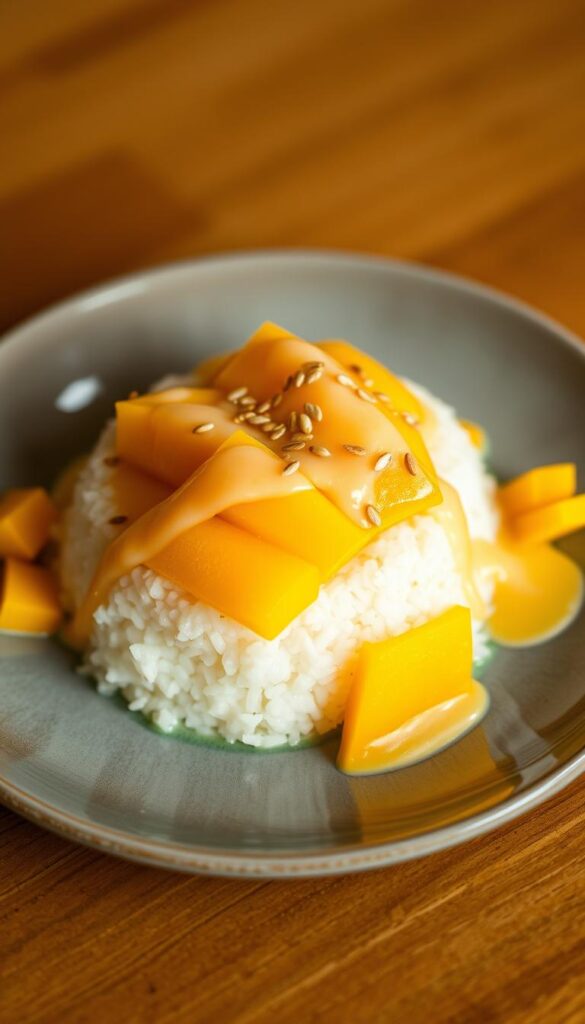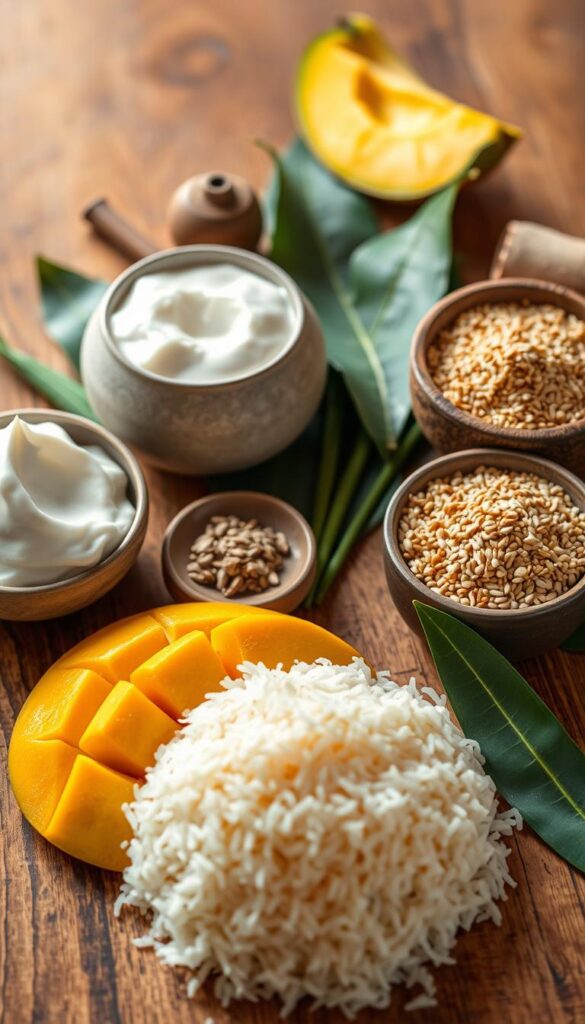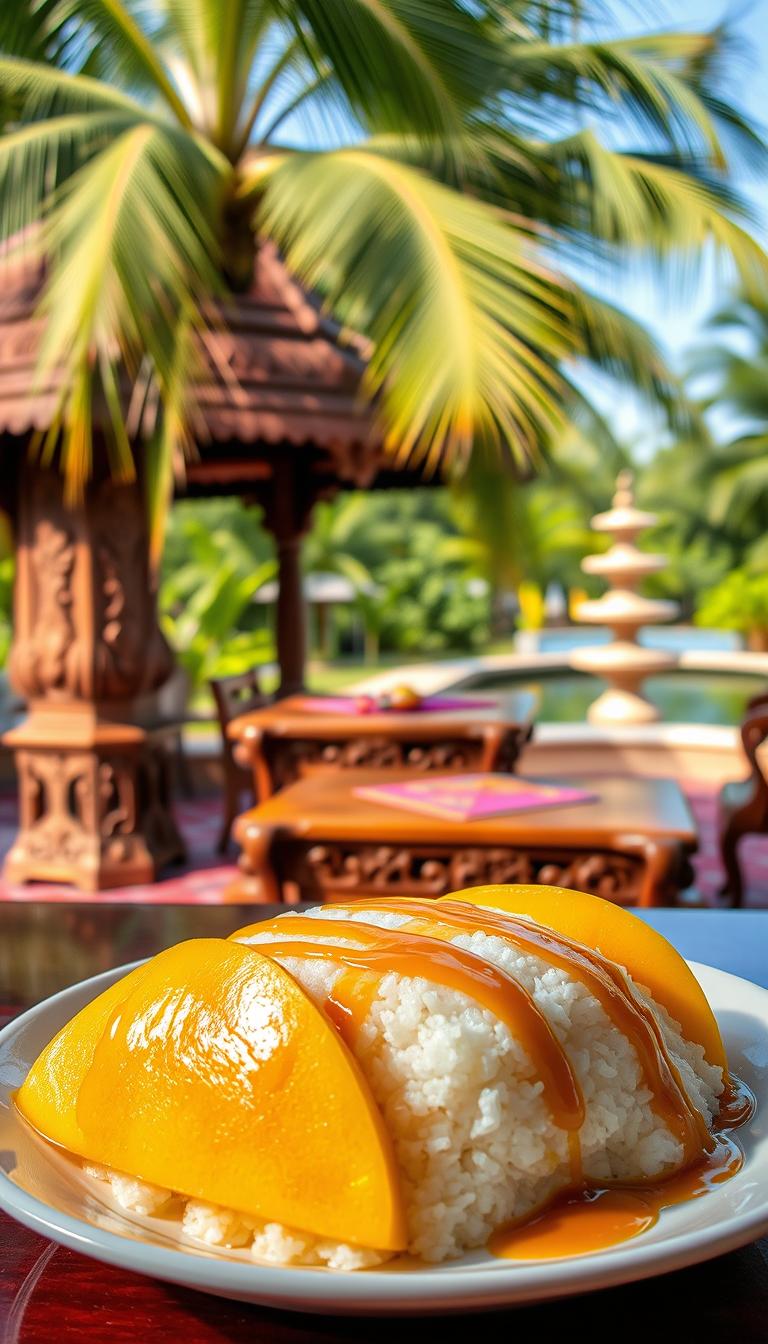The first time I tasted mango sticky rice in Bangkok, it changed my world. I was in a bustling street market. The sweet mangoes and creamy coconut-drenched rice were a perfect mix. It felt like I was right in the heart of Thai cooking.
Mango sticky rice, or “kao niew mamuang”, is more than a dessert. It’s a celebration of fresh ingredients and delicate flavours. It has won the hearts of food lovers all over the world. Every bite tells a story of Thailand’s rich food culture.
Let’s start your journey into this beloved Thai dessert. We’ll look at its origins and how to make it. Whether you love food or want to cook at home, you’ll love this sweet treat.
Are you ready to see why mango sticky rice is loved worldwide? It brings people together with its simple yet amazing taste. Let’s explore this incredible Thai dessert together.
Understanding Thai Mango Sticky Rice (Khao Niaow Ma-Muang)

Mango glutinous rice is a treasure from Thailand’s food culture. It’s known as Khao Niaow Ma-Muang and is loved for its simple yet amazing taste. This dessert is a true delight.
Sticky mango rice is more than a dessert; it’s a cultural experience. It’s most popular from March to May, when mangoes are in season. The yellow mangoes and sweet glutinous rice together are a treat for the taste buds.
Thai cuisine celebrates this dessert as a sign of its culinary creativity. Each region has its own way of making it, showing the diversity of Thai food. Whether it’s from street vendors or fancy restaurants, mango glutinous rice is a favourite.
Knowing the cultural importance of this dessert shows its value beyond being a sweet treat. It connects farming traditions, seasonal food, and the joy of food experiences.
Essential Ingredients for Authentic Mango Sticky Rice

To make perfect sticky rice in Thailand, you need the right ingredients. Start with high-quality Thai white glutinous rice. This rice gives the dish its unique texture and flavour.
For your sweet rice and mango, a few key things are important. Premium coconut milk is a must. Thai chefs often recommend Aroy-D for its rich, creamy taste. Choose full-fat coconut milk for a luxurious feel and deep flavour.
Sugar is key to balancing the dessert’s taste. Traditional Thai recipes use palm sugar or white granulated sugar. A pinch of salt adds to the sweetness and complexity. Ripe, golden mangoes add a burst of tropical freshness, perfect with the creamy rice.
When picking ingredients, go for quality and authenticity. Choose fresh, ripe mangoes for the best taste. The right mix of these ingredients makes your sticky rice dessert unforgettable.
Selecting the Perfect Mangoes for Your Dish

Choosing the right mangoes is key for a delicious mango and sticky rice dessert. In Thailand, Nam Dok Mai mangoes are the top choice. They offer a sweet taste and perfect texture.
These golden-yellow mangoes are the traditional pick for mango sticky rice. But, if you can’t find Nam Dok Mai, Ataulfo mangoes are a great alternative. Look for mangoes that are slightly soft, with a bright yellow-orange colour and few green spots.
When picking mangoes, check if they’re ripe. A ripe mango smells sweet near the stem and feels slightly soft. Stay away from mangoes with brown spots or too soft areas, as they’re overripe.
Pro tip: Choose mangoes that are ripe but still firm. The best mango will be sweet, juicy, and keep its shape when served with sticky rice.
Choosing and Preparing Thai Glutinous Rice
Exploring sticky rice in Thailand means picking the right glutinous rice. It’s different from regular white rice. You need special ways to prepare it to get the right texture and taste.
First, choose high-quality glutinous rice grown in Thailand. Look for labels that say sweet rice or glutinous rice. Rinse the rice well to remove extra starch. This makes it stick together perfectly, just like in traditional Thai desserts.
Soaking the rice is key. Put it in cool water for at least four hours, or better, overnight. This makes sure the grains soak up water evenly. When you steam it, it will have a uniform texture.
Drain the rice carefully before steaming. This stops it from getting too wet.
Pro tip: If you can’t find real Thai glutinous rice, try Asian grocery stores or special food markets. Some online shops also sell genuine Thai rice. This lets you make authentic mango sticky rice at home.
The Art of Making Coconut Sauce
Making the perfect coconut sauce is key to your mango sticky rice recipe. It turns a simple dish into a rich, creamy treat that excites your taste buds. You aim to mix sweetness and saltiness just right, with the perfect consistency.
Choose top-quality coconut milk for the best flavour. Mix it with sugar and a bit of salt in a saucepan. Heat it gently, stirring constantly to avoid burning and keep it smooth. Using palm sugar gives your dish a traditional taste.
Chefs make two sauces: one for mixing with rice and another for drizzling. The mixing sauce is thinner, soaking into the rice. The drizzling sauce is thicker, making a nice glaze. Adjust the sugar to your taste, keeping in mind the sauce should enhance the mango’s sweetness.
When making your sauce, watch the temperature closely. Take it off the heat when it starts to simmer. This stops it from separating and keeps it smooth. Let it cool a bit before serving to get the best coating on your mango sticky rice.
Step-by-Step Sticky Rice Steaming Guide
Steaming sticky rice is a key skill in Thai cooking. You need a bamboo steamer basket for authentic sticky mango rice. If you’re making thai sticky rice at home, follow these steps carefully.
Begin by soaking glutinous rice for hours. This step helps the rice soak up moisture and cook evenly. Place your bamboo steamer over boiling water, making sure the rice doesn’t touch the water. Cover it with a lid to trap steam and cook perfectly.
Spread the rice evenly in the steamer basket. Steam for 20-25 minutes, turning the rice occasionally for even cooking. The rice is done when it’s translucent and soft but still firm.
If you don’t have a bamboo steamer, a fine mesh stainless steel strainer can be a good substitute. The important thing is to keep the steam consistent and avoid water contact. Whether you use a bamboo steamer or a strainer, being patient and careful will help you make great sticky rice.
Creating the Perfect Coconut Milk Mixture
Making the perfect coconut milk mixture is key for mango sticky rice. It’s all about finding the right balance of flavours. You want a smooth, creamy texture that goes well with the sweet rice and fresh mango.
Choose high-quality coconut milk for the best results. Full-fat coconut milk is ideal, giving a rich and luxurious feel. You’ll need to measure carefully: one cup of coconut milk needs two to three tablespoons of sugar and a pinch of salt.
When heating the coconut milk, be gentle. Use low to medium heat and stir constantly to avoid separation. Adding a pandan leaf can add a special aromatic touch, making your dessert stand out.
Remember to taste as you go while making the coconut milk mixture. Aim for a sweet and creamy balance that coats the sticky rice and mango perfectly. Each ingredient is important for a great mango sticky rice experience.
Natural Colouring Options for Sticky Rice
Thai cuisine loves to get creative with natural rice colourings. When making sticky mango rice, you can turn white glutinous rice into a colourful dish. Pandan leaves give it a lovely green colour, while butterfly pea flowers make it enchanting blue.
Turmeric adds a beautiful yellow shade that matches ripe mangoes perfectly. Black sticky rice gives it a deep purple colour, making it visually stunning. These natural colours not only make your dessert look great but also add unique flavours.
Finding these ingredients is easy. You can find pandan leaves, butterfly pea flowers, and turmeric at local Asian grocery stores. Think about the flavour you want when choosing your colouring. Each colour brings its own taste to your mango sticky rice, making it a feast for the senses.
Trying out these natural colours lets you make your sticky rice special. It turns a simple dessert into a work of art that honours Thai cooking traditions.
Mango Sticky Rice: Assembly and Presentation
Creating a stunning mango and sticky rice dish is all about presentation. Your dish should look as good as it tastes. Choose a clean, white plate to show off the dish’s vibrant colours.
Start by making a neat mound of glutinous rice on one side of the plate. Cut ripe mangoes into elegant fan shapes or cubes. Place them next to the rice for a striking contrast.
Drizzle the salted coconut sauce over the rice, letting it flow down the sides. Add toasted sesame seeds or crispy mung beans on top for crunch. These touches boost the flavour and add a professional finish.
For a fresh look, serve the parts in separate dishes or on a wooden board. This lets diners mix their own perfect bite. They can combine sweet mango, creamy rice, and rich coconut sauce as they like.
Traditional Garnishes and Toppings
Authentic mango sticky rice gets a boost from traditional garnishes. In Thailand, crispy mung beans are a must-have. They add a delightful crunch and texture to your dessert.
To make these crispy mung beans, start by soaking them. Then, drain them well. Next, toast the beans in a dry pan until they turn golden and crunchy. This creates a nutty, crisp topping that’s perfect with the soft, sweet sticky rice.
Other classic garnishes include toasted sesame seeds and delicate coconut flakes. These add unique textures that make the dish even better. Sprinkle them over your mango sticky rice for a restaurant-quality look.
Thai chefs also try out other toppings like roasted peanuts or a light dusting of sea salt. The goal is to mix flavours and textures in a way that pleases the palate.
Storage and Reheating Tips
Keeping mango sticky rice fresh is key. Store leftovers in the fridge to keep the taste alive. Use an airtight container for up to three days to keep it fresh.
Freezing is also a great way to keep mango sticky rice. Wrap it in plastic or use a freezer-safe container. It can stay frozen for about a month, keeping its texture.
When reheating, be gentle. Cover the rice with a damp towel to stop it from drying. Microwave in short bursts, checking it often. Usually, 30-45 seconds is enough to warm it up right.
Pro tip: Store the rice, sauce, and mango separately if you make it ahead. This keeps everything fresh and prevents the rice from getting soggy.
Health Benefits and Nutritional Information
Enjoying sweet rice and mango is a treat that’s good for you too. This Thai dessert is not just tasty but also packed with health benefits. It’s made with ingredients that give you essential nutrients.
Mangoes add a nutritional boost to this dessert. They’re full of vitamins A and C, which are great for your immune system and skin. Mangoes also have antioxidants that protect your cells. So, every bite of mango and sticky rice is a treat for your body.
The dessert is high in calories because of coconut milk and glutinous rice. A normal serving has about 300-400 calories. It’s not low in calories, but it can be part of a healthy diet if enjoyed in moderation. The coconut milk has healthy fats that might help your metabolism.
To enjoy it while keeping your diet balanced, try eating smaller portions. Choose ripe, fresh mangoes and use coconut milk sparingly. This way, you can still enjoy the delicious mango sticky rice without overdoing it.
Common Mistakes to Avoid When Making Mango Sticky Rice
Making authentic sticky mango rice can be challenging for home cooks. Many face issues with techniques that make this dessert special. Knowing common mistakes helps you make perfect mango sticky rice every time.
Soaking glutinous rice is key for a great sticky mango rice experience. Don’t skip soaking the rice for 4-6 hours. Not soaking long enough makes the rice hard and uneven.
Steaming is also crucial. Overcooking makes the rice mushy, while undercooking leaves it crunchy. Use a bamboo steamer and watch the time closely.
The coconut sauce needs careful attention. Too much sugar or unbalanced flavours are common mistakes. Aim for a sweetness that enhances the mango without overpowering it. Adjust the flavours gradually as you taste.
Serving temperature is important too. Serve the rice slightly warm or at room temperature. Refrigeration can make the rice hard and lose its creamy texture, which is loved in Thai cuisine.
Seasonal Considerations and Best Times to Serve
Finding the best time to enjoy mango sticky rice is all about the season. In Thailand, the mango season is from March to May. This is the perfect time to try this sweet dessert.
Outside of Thailand, like in the UK, mangoes might be imported. This can extend the season. In tropical areas, mangoes are often available all year. Summer events, like garden parties, are great times to serve mango sticky rice.
If fresh mangoes are hard to find, frozen or canned ones are good alternatives. They let you enjoy mango sticky rice any time of the year. Frozen mangoes thaw well and keep the dessert’s sweetness and texture.
Thai celebrations, like Songkran, are also great times for mango sticky rice. It’s not just a dessert but a way to connect with Thai culture.
Where to Find the Best Mango Sticky Rice in Thailand
Exploring sticky mango rice in Thailand is a culinary adventure you won’t forget. Bangkok and Chiang Mai are top spots for food lovers. Street vendors and dessert shops offer the real deal.
In Bangkok’s markets, like Yaowarat Road in Chinatown, you’ll find amazing sticky mango rice. Look for small family stalls where recipes have been passed down for generations. These places serve the best sticky mango rice Thailand has.
Chiang Mai offers unique takes on this dessert, showing off northern Thai cooking. Local markets and street food areas let you try different versions. Each place adds its own twist, reflecting local traditions and tastes.
When searching for the best sticky mango rice, focus on fresh mangoes and steamed glutinous rice. Choose vendors who use high-quality coconut milk. Your taste buds will be grateful for these authentic experiences across Thailand.
Modern Interpretations and Variations
Chefs around the world have made the mango and sticky rice dessert their own. They’ve turned this traditional Thai dish into something new and exciting. Now, you can find creative versions in fancy restaurants and even in home kitchens.
Ice cream makers have also jumped on the bandwagon. They’ve created unique frozen treats that bring the dessert to life. Some chefs now serve it as a deconstructed dish, showing off each ingredient separately. Others mix it with dishes from other cultures, making it a global treat.
For those watching their diet, there are lighter versions of the dessert. Vegan chefs use coconut milk instead of dairy, and nutritionists try out sugar substitutes. These changes keep the dessert tasty while fitting different diets.
Today’s mango sticky rice recipes might include chia seeds, quinoa, or even spring rolls. This shows how versatile the dessert is. It’s a chance for food lovers to try new things and enjoy the classic flavours in new ways.

